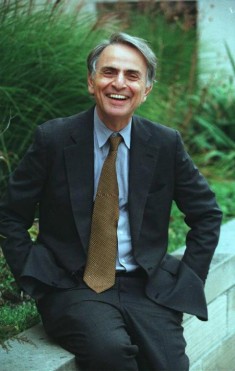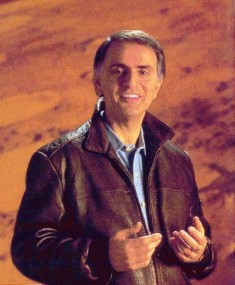| Carl Sagan | |
|---|---|
 |
|
| Astronomy Professor | |
| Specialty | Astronomy, astrophysics, cosmology |
| Born | Nov. 9, 1934 Brooklyn, New York |
| Died | Dec. 20, 1996 (at age 62) Seattle, Washington, US |
| Nationality | American |
Carl Sagan was an astronomer, cosmologist, author, and popularizer of science from the United States. His professional career was spent mostly at the Laboratory for Planetary Studies at Cornell University. Sagan was the author of over 600 scientific papers, as well as being the editor or author of about two dozen books. He was a strong advocate of skepticism in scientific inquiry, as well as being active in the Search for Extra-Terrestrial Intelligence, or SETI. Sagan co-wrote and narrated the well-received TV series, Cosmos, in 1980, and frequently appeared on talk shows.
Early Life and Education
Sagan was born on November 9, 1934, in Brooklyn, New York. He was born into a relatively modest household: his mother was a stay-at-home housewife while his father worked in the clothing industry. After a successful but unexceptional school career, Sagan was able to continue his education at the University of Chicago.
He graduated with a bachelor’s degree in science in 1955, following it up the following year with a master’s degree. Both of these qualifications were attained in physics, but he then decided to specialize in astrophysics and astronomy for his doctorate, which he was awarded in 1960.
In the 1960s, Sagan taught for several years at Harvard before moving to Cornell University in 1968. He spent the first few years there as an assistant professor, finally gaining full professorial status in 1971, after which he was in charge of one of the university’s laboratories. He was an important contributor to the majority of the unmanned space missions to the solar system that were launched in this period, and was the person who came up with the idea of leaving what he called a “universal message” on spacecraft in the hope that it would be discovered and deciphered by any extraterrestrial beings that encountered it.
Sagan and SETI
 The first of Sagan’s suggested messages was the gold plaque that was attached to Pioneer 10, a space probe which would eventually reach the edge of the solar system and pass into interstellar space. He repeatedly encouraged other scientists to use large radio telescopes to use then in the search for extra-terrestrial intelligence, or SETI. Sagan believed that a multitude of unmanned probes should be sent out with the explicit intention of encountering life on other planets. He used his editorship of Icarus, a respected professional journal which published material about research on planets, to put his case for more than a decade.
The first of Sagan’s suggested messages was the gold plaque that was attached to Pioneer 10, a space probe which would eventually reach the edge of the solar system and pass into interstellar space. He repeatedly encouraged other scientists to use large radio telescopes to use then in the search for extra-terrestrial intelligence, or SETI. Sagan believed that a multitude of unmanned probes should be sent out with the explicit intention of encountering life on other planets. He used his editorship of Icarus, a respected professional journal which published material about research on planets, to put his case for more than a decade.
Sagan was a member of SETI’s Institute Board of Trustees, as well as being the joint founder of the Planetary Society. He felt that the Drake equation, which estimated the chances of alien life according to a number of other estimates and assumptions, pointed to there being a considerable number of civilizations elsewhere in the universe.
However, Sagan pointed out that the Fermi Paradox, dealing with the lack of actual evidence of extraterrestrials, probably meant that such civilizations were usually doomed to collapse within a relatively short time, possibly from self-destruction. This, Sagan stated, had serious implications for humanity’s own future.
Popularizing Science
Sagan’s work on SETI informed his interest in getting across to the public the risks to humanity that went with threats such as nuclear winters. He co-wrote an important scientific paper on that subject, and used the intense greenhouse effect that exists on Venus as a deliberately extreme example of what could happen to the Earth if greenhouse gases were allowed to multiply unchecked.
Meanwhile, Sagan also made studies of the Martian seasons and aspects of the then little-known Saturnian moon, Titan. In 1980, he presented the acclaimed popular science program, Cosmos, in which he explained his view of Earth as just one part of an enormous universe.
Sagan’s interest in skepticism increased later in life. In the 1990s, he published The Demon-Haunted World, a strong attack on pseudocience and irrationality in which he provided a toolkit for testing whether views presented were reasonable or fraudulent. He emphasized that error followed by correction was an integral part of the scientific method, going so far as to provide a list of his own mistakes.
Personal Life and Death
In his personal life, he had become a regular smoker of marijuana, although this was not publicly disclosed until after his death. His last years were painful and difficult due to contracting the blood disorder myelodysplasia. He died on December 20, 1996.